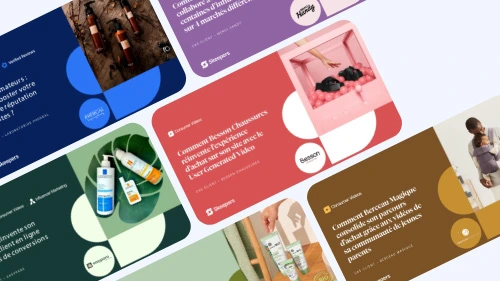In today’s competitive e-commerce landscape, small teams face the challenge of standing out amidst larger competitors. Leveraging User-Generated Content (UGC) has emerged as a powerful strategy for achieving growth and visibility. UGC encompasses content created by consumers, such as reviews, photos, videos, and social media posts, which can significantly impact brand perception and purchasing decisions....
In today’s competitive e-commerce landscape, small teams face the challenge of standing out amidst larger competitors. Leveraging User-Generated Content (UGC) has emerged as a powerful strategy for achieving growth and visibility. UGC encompasses content created by consumers, such as reviews, photos, videos, and social media posts, which can significantly impact brand perception and purchasing decisions. For small teams, harnessing the power of UGC is crucial for establishing brand visibility and fostering meaningful engagement with their audience.
UGC serves as authentic social proof of a brand’s quality and credibility. Unlike traditional marketing content, UGC is generated by real customers who share their experiences, opinions, and recommendations. This authenticity resonates with potential buyers, instilling trust and confidence in the brand and its products. By leveraging UGC, small teams can overcome the skepticism often associated with traditional advertising and connect with consumers on a more personal level.
Understanding UGC in E-commerce

UGC is a cornerstone of modern e-commerce strategies, representing any content created by customers rather than brands themselves. This includes reviews, ratings, testimonials, photos, videos, and social media posts featuring products or experiences.
In e-commerce, UGC serves as authentic social proof that influences consumer behavior and purchase decisions. Unlike traditional marketing content, which is often perceived as biased or promotional, UGC comes directly from real customers who share their genuine opinions, experiences, and recommendations. This authenticity resonates with today’s consumers, who increasingly rely on peer recommendations and authentic content when making purchasing decisions.
Impact on consumer behavior and purchase decisions

Studies have shown that consumers trust UGC more than brand-generated content, with 92% of global consumers trusting recommendations from friends and family, and 70% trusting recommendations from other consumers.
UGC helps build trust and credibility for brands by providing real-life examples of product usage, performance, and benefits. When potential buyers see positive reviews, ratings, or testimonials from fellow consumers, they are more likely to trust the brand and feel confident in their purchasing decisions. Moreover, UGC humanizes the shopping experience, allowing consumers to see products in real-life situations and envision themselves using them. This emotional connection can significantly influence purchase decisions and drive conversion rates for e-commerce businesses.
Benefits of UGC for Small Teams
For small teams in e-commerce, leveraging UGC offers a multiple benefits that can significantly impact their growth and success in the competitive marketplace.
A. Building trust and credibility with authentic content
One of the most significant benefits of UGC for small teams is its ability to build trust and credibility with consumers. Unlike branded content, which can be perceived as biased or promotional, UGC comes directly from real customers who have experienced the products or services firsthand. This authenticity resonates with other potential buyers, who view user-generated content as more genuine and trustworthy. By showcasing authentic content such as reviews, testimonials, and user photos or videos, small teams can establish themselves as trustworthy and reliable brands in the eyes of consumers, fostering long-term relationships and loyalty.
B. Cost-effective marketing strategy for budget-conscious teams
A key advantage of UGC for small teams is its cost-effectiveness as a marketing strategy. Unlike traditional advertising or paid campaigns, which can require significant financial investment, UGC is often generated organically by customers at no cost to the brand. This makes it an ideal option for budget-conscious teams who may not have the resources to invest in expensive marketing initiatives. By encouraging and leveraging user-generated content, small teams can effectively market their products or services without breaking the bank, allowing them to allocate their limited resources more efficiently and achieve greater ROI.
C. Amplifying brand reach and engagement through user participation
UGC has the power to amplify brand reach and engagement by harnessing the participation of users and customers. When customers share their experiences, reviews, or photos/videos featuring products on social media or other platforms, they effectively become brand ambassadors, spreading awareness and generating interest among their own networks. This word-of-mouth marketing can significantly extend the reach of small teams beyond their existing audience, attracting new customers and driving traffic to their e-commerce platforms. Additionally, user-generated content encourages user engagement and interaction, fostering a sense of community and belonging among customers. By actively involving users in the brand’s story and journey, small teams can cultivate stronger relationships and loyalty, ultimately leading to increased sales and growth.
Implementing UGC Strategies
A. Encouraging customers to create and share content

The first step in implementing UGC strategies for small teams in e-commerce is to actively encourage customers to create and share content. This can be done through various means, such as implementing user-friendly review systems on the e-commerce website, sending follow-up emails asking for feedback and reviews, or running social media contests or challenges that encourage users to share photos or videos featuring the brand’s products. By incentivizing and empowering customers to share their experiences, small teams can generate a steady stream of authentic user-generated content that can be leveraged across various marketing channels.
B. Curating and showcasing UGC on e-commerce platforms

Once UGC is generated, small teams should focus on curating and showcasing this content on their e-commerce platforms. This can involve creating dedicated sections or galleries on the website where customers’ reviews, photos, and videos are prominently displayed. Additionally, small teams can integrate UGC into product pages to provide social proof and enhance the shopping experience for potential buyers. By showcasing real-life examples of customers using and enjoying their products, small teams can instill confidence and trust in prospective customers, ultimately driving conversions and sales.
C. Leveraging UGC in social media marketing and advertising campaigns
In addition to showcasing UGC on their e-commerce platforms, small teams should also leverage this content in their social media marketing and advertising campaigns. Social media platforms like Instagram, Facebook, and Twitter are ideal channels for sharing user-generated content, as they allow for visual content to be easily distributed and consumed by a wide audience. Small teams can create branded hashtags to encourage customers to share their content and then repost or feature this UGC on their own social media profiles.
Additionally, small teams can use UGC in paid advertising campaigns to target and engage with specific audience segments, further amplifying the reach and impact of their marketing efforts. By incorporating UGC into their social media strategy, small teams can effectively leverage the power of authentic content to connect with their audience, drive engagement, and ultimately, boost sales and revenue.
Conclusion
In conclusion, leveraging user-generated content can be a game-changer for small teams looking to fuel their e-commerce growth. By harnessing the power of authentic content created by their own customers, small teams can build trust, credibility, and engagement with their audience. user-generated content serves as a cost-effective marketing strategy that allows budget-conscious teams to amplify their brand reach and drive conversions without breaking the bank.
Moreover, by actively encouraging customers to share their experiences and showcasing this content across their e-commerce platforms and social media channels, small teams can create a dynamic and immersive shopping experience that resonates with their audience. Integrating UGC strategies into e-commerce growth plans not only helps small teams stand out in a crowded marketplace but also fosters meaningful connections with customers that can lead to long-term success and loyalty. As small teams continue to navigate the ever-evolving landscape of e-commerce, prioritizing user-generated content as a core component of their marketing strategy will be essential for driving sustained growth and competitiveness in the digital marketplace.













